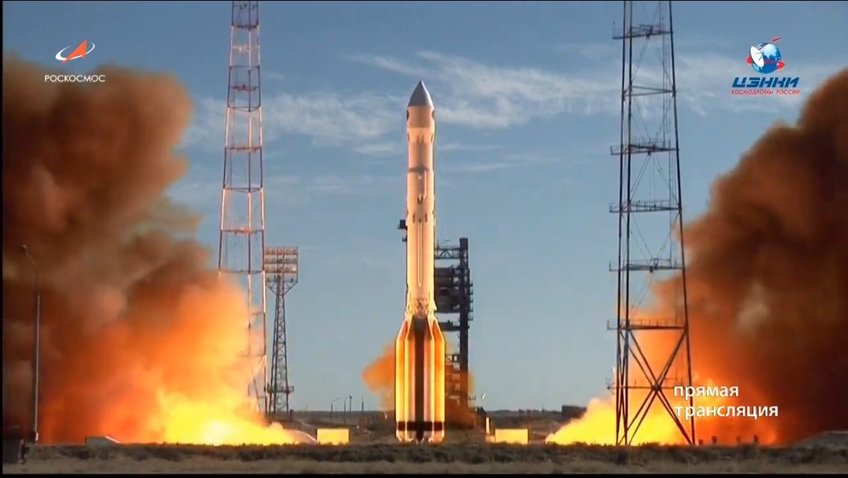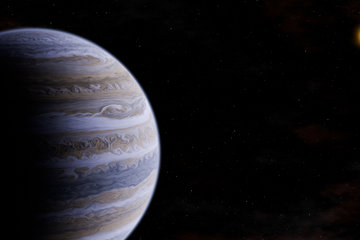The entire sky in X-rays
The eRosita space telescope was launched on July 13 to provide deep insights into space
The small fleet of X-ray space has gained a new flagship. On 13 July 2019, at 14:31 CEST, the German telescope eRosita successfully lifted off from the Baikonur Cosmodrome in Kazakhstan. The launch was originally scheduled for June 21, but had to be delayed three times due to problems with the Proton M launcher. On a platform on board, alongside eRosita, which was developed built by a consortium of German institutes led by the Max Planck Institute for Extraterrestrial Physics in Garching, there is a Russian telescope called Art-XC. The main goal of the eRosita mission is the first complete sky survey in the medium X-ray range up to an energy of ten keV.

eRosita marks the beginning of a new era in X-ray astronomy. Because no telescope before has ever focused on the entire sky in as much detail as eRosita will. “We built eROSITA to transform the way we see the X-ray sky, and to unravel the mysteries of cosmology and black holes”, says Peter Predehl from the Max Planck Institute for Extraterrestrial Physics, the scientific Director of the mission. "The unprecedented spectral and spatial resolution will allow us to study the distribution of huge galaxy clusters and find out more about the mysterious dark energy”.
The question of the nature of the mysterious dark energy, which is tearing the universe apart at an accelerated rate, has occupied astronomers for many years. Dark energy accounts for almost 70% of the total mass of the universe. It eludes direct observation. But together with dark matter, which accounts for about 30% of space, it influences the formation and evolution of galaxy clusters; these are the largest gravitationally bound objects in the universe.
The eRosita Mission
X-ray observations of galaxy clusters provide insights into how the universe is expanding. They also provide information about the proportion of visible matter as well as fluctuations that probably occurred immediately after the Big Bang. The tiny fluctuations in the quantum vacuum prevailing at that time seem to be behind the origin of galaxy clusters and the entire architecture of the cosmos.
In a detailed sky survey, eRosita will map the large-scale structure of the universe and observe around 100,000 galaxy clusters. The researchers are not only focussing their attention on the hot intergalactic medium in these clusters but also on gas and dust in between. On a large scale, these threads of matter give the cosmos the structure of a network; the galaxy clusters arrange themselves at the nodes of this network.
The scientists also expect the X-ray telescope to detect millions of active galactic nuclei containing massive black holes. “Earlier this year, we saw the first image of a supermassive black hole sitting in the centre of a galaxy. eROSITA will now tell us when and where this monster and a million others like it grew over cosmic time," states Kirpal Nandra, Director of the High-Energy Astrophysics group at MPE. "It’s staggering to think how much our understanding of the Universe has advanced."
Within our Milky Way, eRosita will also discover many X-ray sources, including double stars and the remains of stellar explosions (supernovae). Rare objects such as isolated neutron stars (i.e. the burnt out and super dense relics of dead, massive suns) are also on the observation plan.
Gold-plated mirror modules
X-rays cannot be collected and bundled with normal parabolic mirrors such as those found in optical telescopes. This is because X-ray photons have considerable energy. In order to reflect them from a mirror surface, they must enter at a very low angle. Wolter telescopes resemble long tubes in which the mirrors are joined together to increase the number of photons registered. eRosita thus consists of seven identical mirror modules, each with 54 nested shells. These are extremely smooth - the surface “roughness” is 0.3 nm - and gold plated to achieve the necessary reflectivity for grazing incidence. In the focus of each mirror module is a special X-ray camera.

The researchers at the Max Planck Institute for Extraterrestrial Physics have developed a novel detector system based on the light-sensitive electronic components (X-ray CCDs) used in earlier missions. CCDs made of ultra-pure silicon are used for this. These are cooled to a temperature of −90°C and thus achieve a high degree of sensitivity.
In 2016, the last mirror module was integrated into the telescope in the clean room of the Garching Institute. Afterwards, eRosita passed all tests with flying colours. Since 2017, the X-ray scout has been located in Russia, where it was integrated into the Spektrum-RG (for X-ray Gamma) mission together with the Russian secondary instrument Art-XC and finally brought to Baikonur in Kazakhstan. The launch with a Proton M launcher is scheduled for 21 June.
In contrast to its German predecessor Rosat, eRosita will not circle the earth on an orbit. Instead, it will be placed 1.5 million km away. There, at Libration (or Lagrange) point 2, the telescope will not remain stationary but will circumnavigate this point on an extended orbit. One of the advantages is that the telescope retains its orientation in relation to the sun and the earth. Shielding from solar radiation is therefore much easier than on an Earth orbit. The eRosita mission should last about seven years.
International Cooperation
The Max Planck Institute for Extraterrestrial Physics (director), the Institute for Astronomy and Astrophysics of the University of Tübingen, the Leibniz Institute for Astrophysics Potsdam (AIP), the observatory of the University of Hamburg, and the Dr. Karl Remeis Observatory Bamberg, Astronomical Institute of the University of Erlangen-Nuremberg were involved in the construction and development of the eRosita X-ray telescope.
The University Observatory of Ludwig-Maximilians University Munich and the Argelander Institute for Astronomy, University of Bonn also participated in the eRosita project. The Russian partner institute is the Space Research Institute IKI in Moscow; NPOL, Lavochkin Association, Khimky near Moscow, is technically responsible for the entire Spektr-RG mission. The project is supported by the two space agencies in Russia and Germany, Roskosmos and the German Aerospace Center DLR.
HAE / HOR














